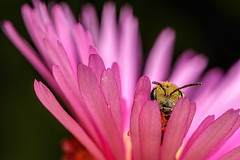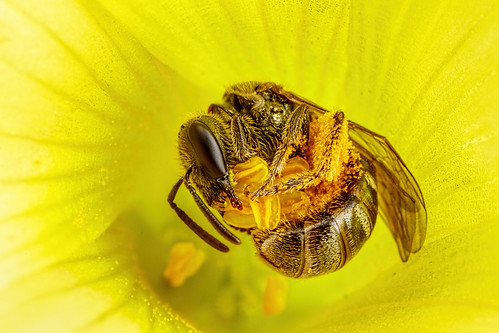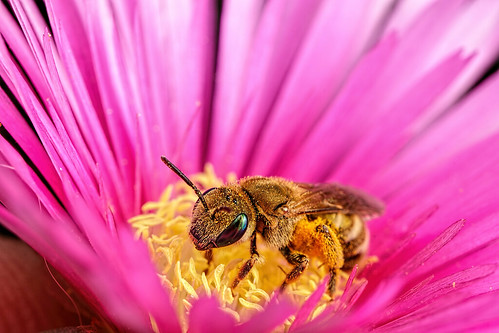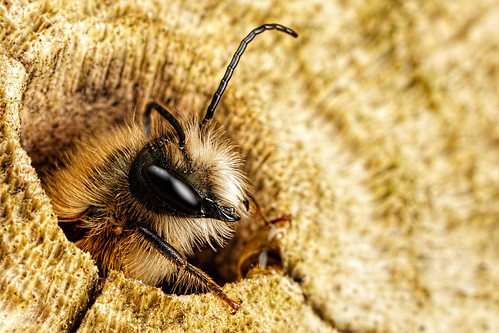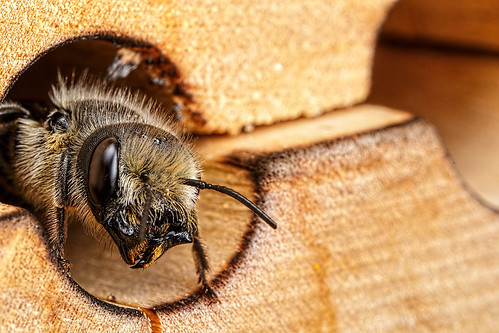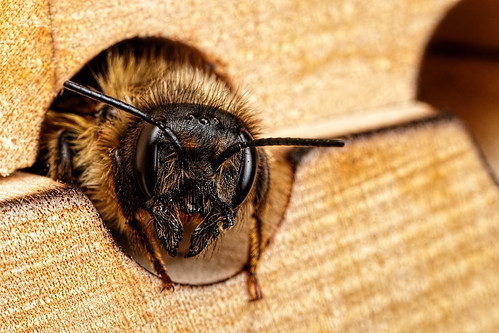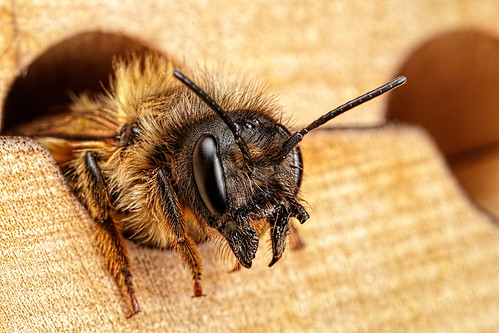Monday, May 25, 2015
Bee-Havior Part 2
When I first got into macro photography I ran into a lot of bad advice, and one misconception that I still see people buying into even today is that you need long glass to shoot skittish or active subjects. Now I’m not saying that’s completely false, there are some critters that you may need a lens in the 150mm plus range to photograph. But that really only holds true if you’re using natural light, and the subject is very skittish. But if you’re using a flash as your primary light source then you need to get your diffusers close to the subject to get really well diffused light, and if your diffusers are close then the working distance of the lens is kinda mute. Add to that the need for a completely calm day with little or no wind when working with long glass and you’ll find yourself limited to what you can do, and when you can do it, when using a big lens.
So what does all of that have to do with shooting bees? Well, what if I told you that one of my “secrets” to taking images of them above life size is to use a short focal length lens and go looking for them on windy days. In fact the windier the day the easier it is to get close to them, because they can’t tell the difference in the vibration caused by the breeze and me grabbing onto the stem of the flower that they are on. Once I have that stem between my left index finger and thumb I rest the lens on that same hand. Now the subject and the camera are on the same “platform” and I have almost full control over the motion in the scene, and I can turn the flower and twist the camera to make the most of what little depth of field there is in a single frame macro image. If I’m really lucky then the skies are partly cloudy and the critters are used to the occasional drop in light, so they’re not concerned when I cast a shadow over them. So although it sounds really counterintuitive it’s sometimes best to use a short focal length lens and go shooting on a windy day :)
I also like to go shooting active subjects early in the morning for two reasons. The first is that they are still trying to get moving and they may just be active and not hyperactive. The other is that they are just like us in that they really need breakfast. So the hungrier they are the more likely they’ll put up with me getting close to them. Later in the day, when there’re not so concerned with eating, it’s going to be more difficult.
Until next time happy shooting :)
Tuesday, May 19, 2015
Daily Deviation Number 8
I just received my eight Daily Deviation at Deviant Art for this image:
El Torro by dalantech on DeviantArt
El Torro by dalantech on DeviantArt
Saturday, May 16, 2015
Bee-Havior Part 1
For the past two years I've had a solitary bee house hanging from a wall at the back of my house, in one of the few places that I had space for one, but the location didn't work. Too many other insects tried to make it a home, and it didn't get any early morning sunlight which is critical for nesting solitary bees. They need the heat of the sun to kick start their metabolism, so they want to nest in areas that get warm early. That's why some Mason Bees built a nesting site in the dead limbs of a tree in my back yard. Here's a male Mason Bee that I photographed shortly after he had hatched out of that nest:
So not long after I took that shot I took the bee house down from the wall and set it on my patio table and cleaned it out (some Earwigs had invaded it). But before I could put it back together a female Mason bee had found the nesting block and had started building egg chambers in it. So after seeing her exit the nesting block I sunk a wood screw into the same tree that the Mason's had built their nest and I hung up the bee house.
The female Mason bee kept coming back to my patio table looking for the bee house...
Not to be outdone by an insect I got an idea: I took the bee house down from the tree, set it back on my patio table, and waited for the Mason bee to go into it. When she did I very slowly picked up the bee house, carried it across the yard, and hung it back on the tree. When she came out she must have imprinted the new location in her mind because she stopped coming to my patio table and is still building out brood cells in the bee house :) Here's the only frame that she has allowed me to take of her so far:
Getting that single frame was tough. I camped out in front of the bee house before sunrise and spent almost two hours trying to acclimate the Mason bees to me and the camera. If they see you move as they are trying to get active they will go back to being dormant. It's like they have a random number generator in their heads and for several minutes they'll just go back to sleep. If you have the camera close to them while they are dormant then they won't notice it when they wake up -they'll think that it's just a part of the scenery. But be warned: Once they are acclimated to you and the camera they will get active very quickly. Once that Mason Bee stuck her head outside of the bee house I had about a minute to photograph her, and as you can see she wasn't sitting still.
As of this blog post I have two Leaf Cutter bees building brood cells in my bee house, with one chamber completely full and another one that's almost done. Even if you're not into macro photography it's a good idea to set up a solitary bee house. They are excellent pollinators and they are also very timid!
Until next time happy shooting :)
So not long after I took that shot I took the bee house down from the wall and set it on my patio table and cleaned it out (some Earwigs had invaded it). But before I could put it back together a female Mason bee had found the nesting block and had started building egg chambers in it. So after seeing her exit the nesting block I sunk a wood screw into the same tree that the Mason's had built their nest and I hung up the bee house.
The female Mason bee kept coming back to my patio table looking for the bee house...
Not to be outdone by an insect I got an idea: I took the bee house down from the tree, set it back on my patio table, and waited for the Mason bee to go into it. When she did I very slowly picked up the bee house, carried it across the yard, and hung it back on the tree. When she came out she must have imprinted the new location in her mind because she stopped coming to my patio table and is still building out brood cells in the bee house :) Here's the only frame that she has allowed me to take of her so far:
Getting that single frame was tough. I camped out in front of the bee house before sunrise and spent almost two hours trying to acclimate the Mason bees to me and the camera. If they see you move as they are trying to get active they will go back to being dormant. It's like they have a random number generator in their heads and for several minutes they'll just go back to sleep. If you have the camera close to them while they are dormant then they won't notice it when they wake up -they'll think that it's just a part of the scenery. But be warned: Once they are acclimated to you and the camera they will get active very quickly. Once that Mason Bee stuck her head outside of the bee house I had about a minute to photograph her, and as you can see she wasn't sitting still.
As of this blog post I have two Leaf Cutter bees building brood cells in my bee house, with one chamber completely full and another one that's almost done. Even if you're not into macro photography it's a good idea to set up a solitary bee house. They are excellent pollinators and they are also very timid!
Until next time happy shooting :)
Subscribe to:
Posts (Atom)

